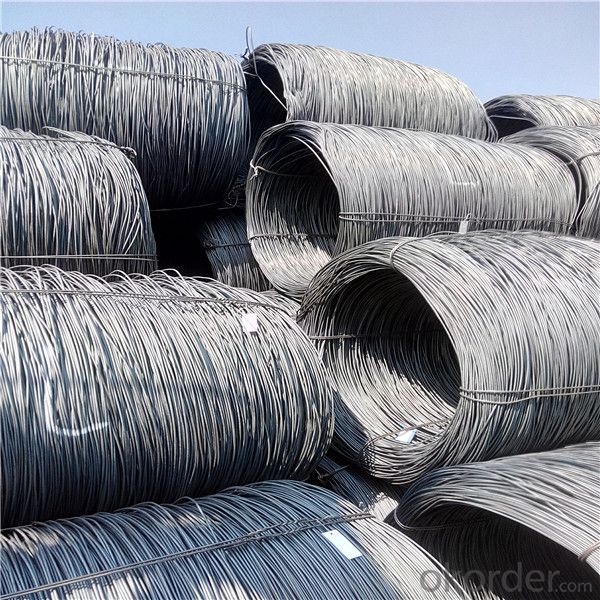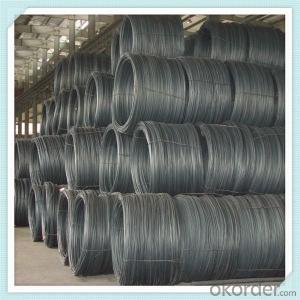Export steel wire rod from China in different grade
- Loading Port:
- China main port
- Payment Terms:
- TT OR LC
- Min Order Qty:
- 100 m.t.
- Supply Capability:
- 12984 m.t./month
OKorder Service Pledge
OKorder Financial Service
You Might Also Like
Item specifice
Drawing Grade wire rods are used by downstream industries for various applications such as making wires for
welded mesh, nails, hangers, screws, chain link & gabion fencing, wire nets, barbed wires and binding wires.
Features
1、Pure steel quality, stable chemical contents, small tolerance.
2、Constant Quality, good drawing performance.
3、High dimension accuracy degree, accuracy degree of Level C up to 80%, smooth surface, less scale,
easy to be pickled.
4、Automatic bundling with 4 lines by Machine in tidy and good looks
5、Big high quality percentage, small coil percentage, and heavy coil weight for Hard Coil.
6、High sorbitizing percentage.
Product Description :
Standard | AISI, ASTM, BS, DIN, GB, JIS |
Material/steel grade | Q195-Q235,SAE1006B,SAE1006CR, SAE1008B, SAE1008CR, SAE1010B, SAE1018B, or according to customers requirements |
Wire Gauge | 5.5-12mm |
Coil weight | 1.8-2.1mts |
MOQ | 25MT |
Delivery Time | 15-30 days after receipt of L/C or deposit by T/T |
Packing | In coil and load in container, if large quantity, by bulk vessel; Can be packed as customers' special requirements |
Payment terms | 1).100% irrevocable L/C at sight. 2).30% T/T prepaid and the balance against the copy of B/L. 3).30% T/T prepaid and the balance against L/C |
Application | widely used in machinery parts, manufacturing industry, electronics industry, metal tools and others |


Application :
It generally used in braiding the hose for bathing product and machinery. With it
good flexibility, resistant to high temperature and resistant to corrosion, it
used widely in many industries.
Packing :
Hot-rolled wire rod is held in a unit with at least four steel straps in the
transverse direction and transported and stored without further packaging.
Before
the steel strapping is applied, the wire rod must be sufficiently compressed.
The strapping is fixed in the transverse direction with a single circumferential
strap so that the strapping does not slip and cause the coil to come apart.


Our service:
(1) We cooperate with famous factories with advanced equipment and well trained workers.
(2) We can provide factory price with trading company service.
(3) We continuously work on the improvement of our processes, guaranteeing
consistently high standards of quality to keep none compensation.
(4) We guarantee 24 hours response and 48 hours solution providing service.
(5) We accept small order quantity before formal cooperation.
(6) We deliver the agreed quality at the agreed time, reacting to changes in
customer wishes in a flexible way.
(7) Due to our volume and selling power, we have excellent freight rates with
shipping lines.
(8) We strive to always be fair and honest in our dealings with customers.
(9) We strive to work together with customers to achieve much more than we can
achieve alone.
(10) Through our passion and commitment we aim to be a market leader in all our
key markets. To maintain our position as market leader we must continue to add
value in all that we do.
FAQ:
1.Q: What's your MOQ(minimum order quantity)?
A: One full container, mixed acceptable .
2. Q: What's your packing methods?
A: Packed in bundle or bulk ..
3. Q: How can I buy CNBM products in my country?
A:Please send us an inquiry or email ,we will reply to you if there is distributor in your country
4. Q: Can we visit your factory?
A: Warmly welcome. Once we have your schedule, we will arrange the
professional sales team to follow up your case.
5. Q: How long does it take to get the product if i place an order?
A:With the process of your requirements,we will pack and deliver in 3
-7 days. If it is by sea shipment,it will take 15-45 days depending on different locations
- Q:What are the different types of steel wire rod heat treatments?
- There are several types of heat treatments for steel wire rod, including annealing, quenching and tempering, normalizing, and stress relieving.
- Q:How is steel wire rod used in the manufacturing of wire forms for ski lifts?
- The manufacturing of wire forms for ski lifts heavily relies on steel wire rod, which is an indispensable component. These wire forms are responsible for delivering the required support and strength to the ski lift system. To begin with, steel wire rod is employed in the creation of primary cables that run alongside the ski lift structure. These cables bear the weight of both the ski lift and its passengers, guaranteeing their safety and stability. The ability of steel wire rod to withstand heavy loads and stress is of utmost importance in the functioning of the ski lift system. Furthermore, steel wire rod is also utilized in the production of suspension cables that connect the ski lift cabins to the primary cables. These suspension cables play a critical role in maintaining the balance and levelness of the cabins while in motion. The dependability and durability of steel wire rod ensure that these suspension cables can endure the constant movement and varying forces exerted on them. In addition, steel wire rod is also employed in the construction of safety cables, which serve as a precautionary measure. These safety cables act as a backup system, providing an extra layer of security for ski lift passengers. In the event of any unforeseen circumstances or malfunctions, the safety cables ensure that the cabins remain firmly attached to the primary cables, preventing any potential accidents. Overall, steel wire rod acts as the backbone of wire forms for ski lifts, offering the necessary strength, stability, and safety required for their operation. The quality and durability of steel wire rod play a vital role in ensuring the reliability and longevity of ski lift systems, ultimately contributing to the safety and enjoyment of skiers and snowboarders.
- Q:What are the different factors that affect the mechanical properties of steel wire rod?
- Steel wire rod's mechanical properties can be affected by various factors. These factors comprise steel composition, heat treatment, rolling process, and impurity presence. Steel composition significantly determines its mechanical properties. Different elements, such as carbon, manganese, and silicon, are added in varying quantities to achieve specific properties. For example, higher carbon content boosts steel strength and hardness, while alloying elements like chromium or nickel enhance corrosion resistance. Heat treatment also has a significant impact on steel wire rod's mechanical properties. This process involves heating the steel to a specific temperature and then rapidly or slowly cooling it to alter its microstructure. Strength, hardness, and toughness can all be affected. Quenching and tempering increase hardness and strength, while annealing improves ductility. The rolling process, which involves mechanically deforming the steel wire rod to reduce its size, also affects its mechanical properties. The amount of reduction, number of passes, and rolling temperature all influence the final properties. Higher reductions and lower rolling temperatures generally result in finer grain structures and improved mechanical properties. Impurities present in the steel, such as sulfur, phosphorus, and non-metallic inclusions, can also impact mechanical properties. These impurities weaken the steel, reducing ductility and toughness. Thus, maintaining low impurity levels through proper refining and alloying processes is crucial to achieve desired properties. In conclusion, steel wire rod's mechanical properties are influenced by multiple factors: steel composition, heat treatment, rolling process, and impurity presence. Understanding and controlling these factors is essential in producing steel wire rods with desired properties for various applications.
- Q:What are the main factors influencing the choice of steel wire rod end-user?
- The main factors influencing the choice of steel wire rod end-user include the specific application requirements, such as tensile strength, corrosion resistance, and durability. Other factors include price, availability, and the reputation and reliability of the supplier.
- Q:What are the factors that determine the price of steel wire rod?
- There are several factors that determine the price of steel wire rod, including the cost of raw materials (such as iron ore and scrap metal), energy costs, market demand and supply, production and transportation costs, government policies and regulations, and global economic conditions. Additionally, factors like technological advancements, competition among steel manufacturers, and currency exchange rates can also impact the price of steel wire rod.
- Q:How is steel wire rod used in the manufacturing of wire forms for agricultural fencing?
- Steel wire rod is used in the manufacturing of wire forms for agricultural fencing by being transformed into various wire shapes and gauges. It can be straightened, cut, and then either woven or welded into the desired fence forms. The high tensile strength of steel wire rod provides durability and resistance, making it suitable for withstanding the pressure and impact that agricultural fencing may encounter.
- Q:What are the common production processes for tool steel wire rod?
- The common production processes for tool steel wire rod include melting and refining the steel, followed by continuous casting to form the wire rod. The rod is then hot rolled to achieve the desired size and shape, followed by heat treatment processes such as annealing, quenching, and tempering to enhance its strength and hardness. Finally, the wire rod may undergo surface treatments like drawing, coating, or polishing before it is ready for use in tool steel applications.
- Q:How is steel wire rod used in the manufacturing of wire rope fasteners?
- Steel wire rod is used in the manufacturing of wire rope fasteners as it serves as the primary material for creating the wire ropes. The wire rod is first drawn through a series of dies to obtain the desired diameter and strength. These wire ropes are then used to form the core of wire rope fasteners, providing the necessary strength and durability to secure and hold various objects together.
- Q:How is steel wire rod used in the manufacturing of wire forms for playground equipment?
- Steel wire rod is an essential component in the manufacturing process of wire forms for playground equipment. The wire rod is typically made from high-quality steel and is available in various diameters to suit different requirements. To create wire forms for playground equipment, the steel wire rod goes through a series of manufacturing steps. First, it is fed into a machine that cleans and removes any impurities from the surface. This ensures that the wire is clean and ready for further processing. Next, the wire rod is passed through a drawing machine, which reduces its diameter to the desired size. This process involves pulling the wire rod through a series of dies, gradually decreasing its diameter and increasing its length. This drawing process not only shapes the wire but also improves its strength and durability. After the wire has been drawn to the desired diameter, it is then annealed to relieve any internal stress and enhance its malleability. This makes it easier to bend and shape the wire into the desired forms for playground equipment. Once the wire has been annealed, it is ready for the forming process. During this stage, the wire is bent, twisted, and shaped using specialized machines and tools. These wire forms can include various components such as hooks, loops, spirals, and curves, depending on the specific design requirements of the playground equipment. The formed wire is then subjected to a heat treatment process known as quenching and tempering. This process further enhances the wire's strength and durability, making it capable of withstanding the rigors of playground use. Finally, the wire forms are coated with a protective finish to prevent corrosion and improve their lifespan. This coating can be a variety of materials, such as galvanization or powder coating, depending on the specific requirements of the playground equipment. Overall, steel wire rod is an integral part of the manufacturing process for wire forms used in playground equipment. Its strength, durability, and malleability make it an ideal material for creating safe and reliable wire forms that can withstand the demands of playground use.
- Q:How is steel wire rod used in the production of wire fencing?
- Wire fencing production relies on steel wire rod as its main raw material. The rod goes through a series of steps, such as drawing, galvanizing, and coating, to transform it into high-quality wire suitable for fencing. To begin, the steel wire rod is drawn through dies that reduce its diameter and increase its length. This process strengthens the wire, making it more durable and resistant to breakage. Afterward, the wire is galvanized by coating it with zinc. This galvanization protects against corrosion, ensuring the longevity of the wire fencing, even in harsh weather conditions. Following galvanization, the wire can undergo further processing to enhance its functionality for specific fencing purposes. For example, it can be coated with PVC to improve its resistance to moisture, UV rays, and other external factors. This not only adds an extra layer of protection but also increases visibility, making it suitable for security fencing or animal enclosures. Once the steel wire rod has been transformed and processed, it is used to manufacture various types of wire fencing. The wire can be woven or welded to create different designs and patterns, depending on the specific fencing project's requirements. It serves various applications, including agricultural, perimeter, construction, and decorative fencing. In conclusion, steel wire rod is vital in wire fencing production. It undergoes multiple processing steps to improve its strength, durability, and resistance to corrosion. The resulting wire is used to manufacture different types of fencing, providing security, protection, and containment for various applications.
1. Manufacturer Overview |
|
|---|---|
| Location | |
| Year Established | |
| Annual Output Value | |
| Main Markets | |
| Company Certifications | |
2. Manufacturer Certificates |
|
|---|---|
| a) Certification Name | |
| Range | |
| Reference | |
| Validity Period | |
3. Manufacturer Capability |
|
|---|---|
| a)Trade Capacity | |
| Nearest Port | |
| Export Percentage | |
| No.of Employees in Trade Department | |
| Language Spoken: | |
| b)Factory Information | |
| Factory Size: | |
| No. of Production Lines | |
| Contract Manufacturing | |
| Product Price Range | |
Send your message to us
Export steel wire rod from China in different grade
- Loading Port:
- China main port
- Payment Terms:
- TT OR LC
- Min Order Qty:
- 100 m.t.
- Supply Capability:
- 12984 m.t./month
OKorder Service Pledge
OKorder Financial Service
Similar products
New products
Hot products
Related keywords


























